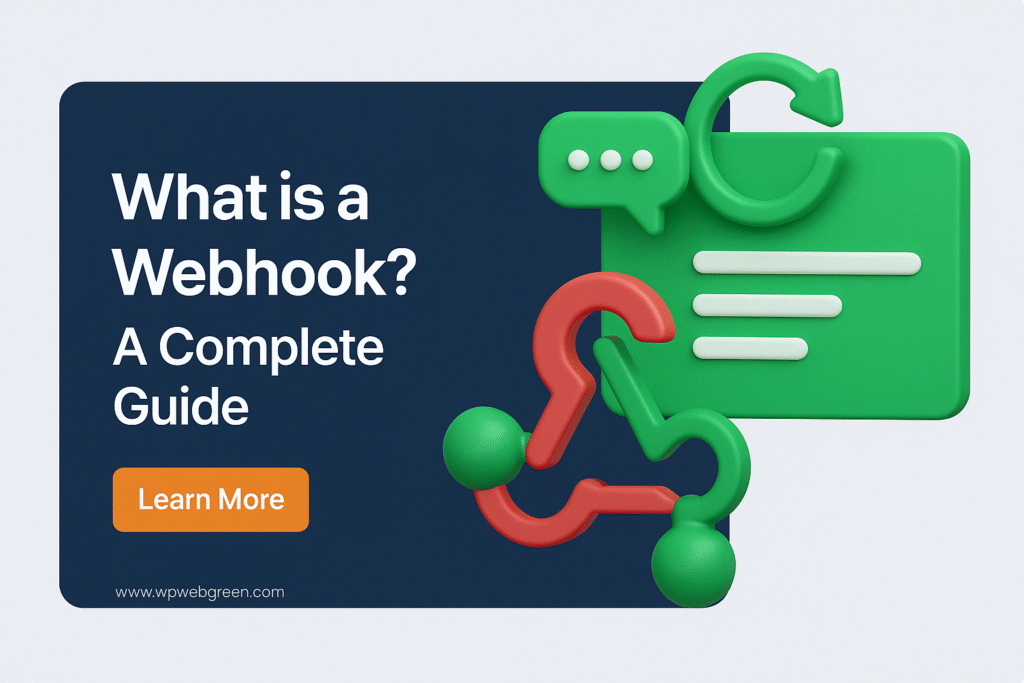Introduction
In the world of web development and automation, webhooks play a crucial role in enabling real-time communication between applications. But what exactly is a webhook, and why is it so important?
In this blog post, we’ll cover:
-
What a webhook is
-
How webhooks work
-
Key differences between webhooks and APIs
-
Common use cases
-
Benefits and limitations
-
Best practices for implementing webhooks
What is a Webhook?
A webhook is an automated method for one application to send real-time data to another application as soon as a specific event occurs. Instead of constantly polling an API for updates, a webhook delivers data instantly when triggered, making it an efficient way to handle event-driven communication.
Webhooks are often referred to as “reverse APIs” or “HTTP callbacks” because they allow a server to push data to a client (or another server) without the client needing to request it repeatedly.
How Do Webhooks Work?
The basic workflow of a webhook involves three main steps:
-
Event Occurs : An event happens in the source application (e.g., a new user signs up, a payment is processed, or a file is uploaded).
-
HTTP POST Request : The source application sends an HTTP POST request (usually in JSON or XML format) to a predefined URL (the webhook endpoint) configured in the receiving application.
-
Data Processing : The receiving application processes the payload and takes the necessary action (e.g., updating a database, sending a notification, or triggering another workflow).
Example Scenario:
-
Use Case: Sending a Slack notification when a new order is placed on an e-commerce site.
Process:
-
A customer completes a purchase.
-
The e-commerce platform triggers a webhook to a Slack webhook URL.
-
Slack receives the payload and posts a message in a specified channel.
Webhooks vs. APIs: Key Differences
While both webhooks and APIs facilitate communication between applications, they work differently:
Feature Webhook API (REST, GraphQL, etc.) Communication Server pushes data to client Client requests data from server Real-Time Yes (event-driven) No (polling required) Efficiency More efficient (no repeated requests) Less efficient (requires frequent polling) Use Case Instant notifications, automation Data retrieval, complex queries Common Use Cases for Webhooks
Webhooks are widely used in various industries for automation and real-time updates. Some popular examples include:
-
Notifications & Alerts
-
Sending Slack/Teams messages when an issue is logged in a project management tool.
-
Email confirmations after a user signs up.
-
-
E-Commerce & Payments
-
Updating inventory when an order is placed (Shopify, Stripe).
-
Processing refunds or failed payments.
-
-
CRM & Marketing Automation
-
Syncing new leads from a form submission to a CRM like HubSpot or Salesforce.
-
-
IoT & Smart Devices
-
Turning on smart lights when a motion sensor is triggered.
-
-
Benefits of Using Webhooks
Real-Time Data Delivery: No delays caused by polling.
Reduced Server Load: Fewer unnecessary API calls.
Automation-Friendly: Enables seamless integration between apps.
Lightweight & Simple: Easy to set up compared to complex API integrations.
Limitations & Challenges
⚠ Security Risks: Webhooks can be vulnerable to attacks if not secured properly (e.g., replay attacks, DDoS).
⚠ Dependency on Endpoint Availability: If the receiving server is down, data may be lost.
⚠ No Built-In Retry Mechanism: Failed deliveries may require manual handling.
Best Practices for Implementing Webhooks
To ensure reliability and security, follow these best practices:
-
Use HTTPS: Always secure webhook endpoints with SSL/TLS.
-
Validate Payloads: Verify incoming requests using signatures.
-
Implement Retry Logic: Handle failed deliveries with exponential backoff.
-
Rate Limiting: Prevent abuse by limiting incoming requests.
-
Log Webhook Activity: Keep records for debugging and auditing.
Conclusion
Webhooks are a powerful tool for real-time data exchange between applications, reducing the need for constant polling and enabling seamless automation. By understanding how they work, their benefits, and best practices, developers can leverage webhooks to build efficient, event-driven systems.
Whether you’re automating notifications, syncing data between platforms, or integrating third-party services, webhooks provide a fast and efficient solution. Thank you for reading


